At Overthinking It, Law & Order is analyzed by two separate yet equally important groups: the people who watch the show and send in the data, and the people who build the spreadsheets. These are their findings…

Last May, I mourned the end of L&O by announcing a crowdsourced effort to catalog the outcome of all 456 episodes. At first, the responses poured in, as bountiful as Lenny’s wisecracks. After a month of so, everyone trailed off… except for a reader named Josh Kyu Saiewitz, who decided that this was the perfect opportunity to watch every Law & Order episode, in order. (If you think that’s impressive, you should check out Josh’s blog, where he’s attempting to consume every comic, TV show, movie, and video game featuring Batman, all in chronological order. He’s up to 1941.)
Josh recently made it through the halfway mark of the series. I won’t say he’s a hero – because what’s a hero? – but this post would be impossible without his efforts.
So… are you ready to Excel?
“Implied Guilty” refers to any episode where we didn’t actually see the defendant get convicted or plea out, but the show leaves us with the strong feeling it’s going to happen. For instance, the defendant’s wife tearfully agrees to testify against him. “Guilty of lesser charge” is when the DA was going for Murder 1, but the jury only convicts of Man 2 and Tampering With Evidence.
If you watch the show, you won’t be surprised that “Plea bargain” is the most common outcome. What might surprise you is that in the real world, over 95% of felony convictions come from plea bargains. You could argue that this makes L&O unrealistic. But who says that Jack McCoy doesn’t settle 95% of his cases? The series is only a record of his most interesting cases, so naturally we get a lot of trials. I’m sure Sherlock Holmes had a lot of boring cases, but Watson didn’t bother writing about those.
Okay, now let’s break it down season by season. The years represent when each season started.
What’s immediately striking is how few plea bargains there were in the first season. All these cases not only went to trial, they went all the way to the verdict. This makes for good TV, but it makes the show less realistic. We never see Matlock negotiate a plea bargain, but nobody is mistaking Matlock for a realistic courtroom drama. On the other hand, we like to watch L&O and flatter ourselves that we understand a little bit of how the criminal justice system really works. In any case, by the show’s fourth season, over 40% of the episodes ended with a plea. That’s a fourfold increase.
Let’s kick it up a notch (bam). I combined the plea bargains and Guilty verdicts to calculate each season’s “Success Rate” — the percentage of episodes in which the DAs got their man. However, there are instances where I counted Guilty verdicts and pleas as failures (when the DA wanted a conviction for murder and had to settle for something less). Don’t worry: you can download my spreadsheet at the end of the post. Most of Josh’s notes are in there, so you can see why we decided the way we did.
The success rate started high, went higher, and then plummeted to a bleak 59% in the 1993 season. That means in 2 out of every 5 episodes that year, the bad guy got away with it. That was followed by a dramatic reversal, as the series shot up to its highest conviction rate, before leveling off at a so-stable-I-almost-think-Dick-Wolf-planned-it 75%.
Okay, you say. Pretty chart. So what?
HERE’S what:
You see, 1990 was not only the first year of L&O, it was the high point for murders in New York City. There were more murders that year than at any point in the 1970s or 80s, and the body count stayed high throughout the early 90s. You see this reflected in the series. Sure, Law & Order started off with a lot of feel-good outcomes, because in 1990 a brand new show couldn’t afford to frustrate audiences. But the tone of the show quickly became one of helplessness and futility, to reflect how the people of New York were losing faith in actual law and order.
But in November 1993, at the same time the DAs of L&O were stumbling to a 59% success rate, Rudy Guiliani was elected Mayor. One of his big campaign issues had been, well, law and order, and tackling the crime rate was the centerpiece of his first year:
In his first term as mayor, Giuliani, in conjunction with New York City Police Department Commissioner Bill Bratton, adopted an aggressive enforcement-deterrent strategy based on James Q. Wilson’s “Broken Windows” approach. This involved crackdowns on relatively minor offenses such as graffiti, turnstile jumping, cannabis possession, and aggressive “squeegeemen”, on the theory that this would send a message that order would be maintained.
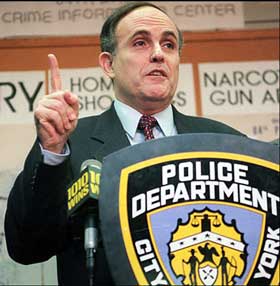 Italics mine. Here’s why I think this is interesting: Giuliani didn’t just fight crime, he fought crime in a lot of very visible ways that average New Yorkers would take note of. I don’t mean to take anything away from his acheivements — there was a remarkable drop in crime during his administration. But even before the murder rate started dropping, Giuliani created a strong public perception that there was a new sheriff in town. He restored people’s faith in law and order, and Law & Order immediately responded.
Italics mine. Here’s why I think this is interesting: Giuliani didn’t just fight crime, he fought crime in a lot of very visible ways that average New Yorkers would take note of. I don’t mean to take anything away from his acheivements — there was a remarkable drop in crime during his administration. But even before the murder rate started dropping, Giuliani created a strong public perception that there was a new sheriff in town. He restored people’s faith in law and order, and Law & Order immediately responded.
Take a look at 1994 on the chart above. The murder rate dropped by about 15%, and the L&O conviction rate shot up by more than 20%. There was a whole new feeling of optimism in the city and on the show (not to mention a young new DA by the name of Jack McCoy).
Actually, an 80% conviction rate is probably a little boring from a dramatic perspective, so it’s not surprising that the number goes down a little in subsequent seasons. Still, the real world murder rate continues to drop, and the L&O conviction rate stays high.
This all makes me very curious to follow the show out of the 90s, into the turbulent years after 2001. Does the conviction rate go down as people start to worry about the government’s ability to keep them safe? I’ll let you guys know as soon as I get all the data (no pressure, Josh). In the meantime, you’re welcome to use my spreadsheet for your own analysis, as long as you post your findings in the comment thread.
Ka-CHUNG.
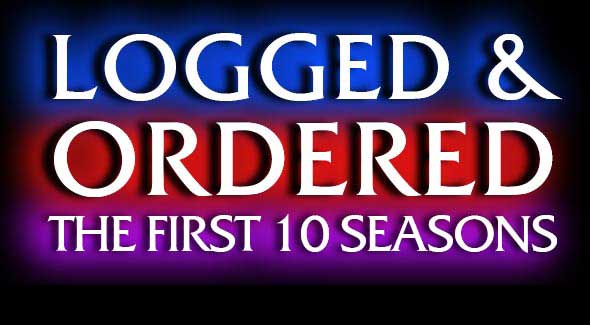
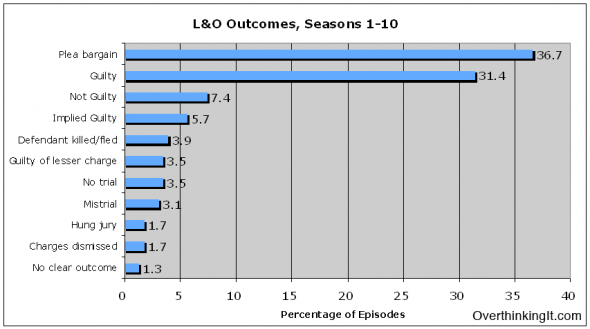
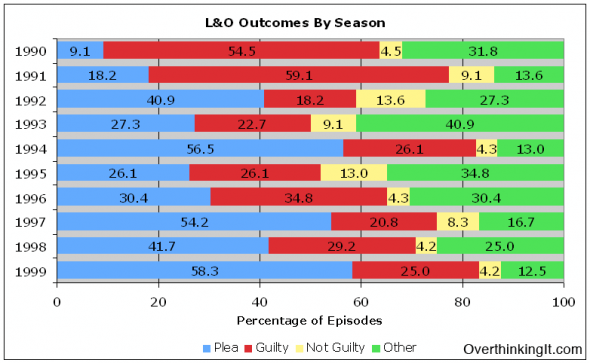
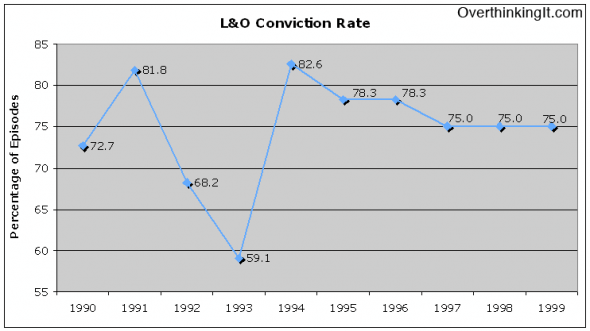
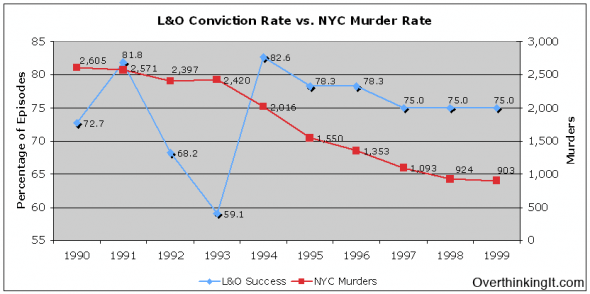
*Slow clap*
*Joins in with slow clap*
*Slow Ka-CHUNG*
If you won’t say it, I will: Josh, you’re a hero. The writeup is awesome too, Matt.
I don’t know why Law & Order: Compstat Meetings wasn’t more popular.
This is really cool.
Would you mind more thoroughly looking at Ben Stone’s rates of conviction/plea bargains v.s those of Jack McCoy’s?
Or, even more interesting to me would be analysis by ADA. I have my favorites (RIP, Claire); and they all had such different personalities/points of conflict.
While I’m happy of the article and to see the Law and Order database (which I should have participate considering bravo show Law and Order everyday, sadly its on my supper hour meaning I have an hard time seeing them completly)
Although shouldn’t we consider that L&O doesn’t necessarly reflect the direct state of thing but more of how they were last year? I mean an episode take sometime to put itself together
Keep in mind that a season of Law & Order premieres at the very END of the year – usually late September – and it runs until May of the following year. So there’s already a nine month delay built into these charts. I’d argue that although Guiliani didn’t take office until the beginning of 1994, the Law & Order season that began at the end of 1994 definitely reflected his impact. For instance, here’s a big speech he gave on crime in March of 1994, well before any episodes of the 1994 season were planned:
http://query.nytimes.com/gst/fullpage.html?res=9a01e2d9173cf933a15750c0a962958260
I appreciate the precision, thank you
Although now I have this bizzare idea of a paralell world were the TV season start in January instead of September leading to completly different “Rip off from the headline ” episode for Law & Order
:D
It seems to be a rule in the L&O franchise that the wealthiest person introduced in the first half of the show is the most likely to be the person on trial in the second half of the show. It would be interesting to compare the Socio-economics of L&O compared to the real world.
The most recognizable actor or guest star is almost always guilty.
I think this post just gave me a hard-on.
I’d like to see something like this done for The Shield. I was always amazed at their murder solving rate. With Dutch being able to solve about a murder a day, and usually being able to solve it WITHIN a day of the murder occurring, you’d think that’d be some serious deterrent to criminals in LA.
[Gushing] This is awesomely researched, edited, done, etc. Great work!
this kind of avoids the elephant in the L&O room – they always arrest the wrong guy in the first half of the show – any real copy would be up to their necks in false arrest law suits and would have long ago been fired
Every environmentalist I’ve seen on L & O has been a real @ssh*le and thoroughly disagreeable person.
Please do not give Giuliani a large credit for reducing crime in NYC. Almost every single US city had a similar reduction in crime during the same period. This was due to shifting demographics in the US. During this period the number of young males (who commit the vast majority of crimes) dipped and the economy started booming. Crime stats are very tightly linked to changes in demography! Giuliani could have sat on his a$$ and done nothing and the NYC crime rate would have gone down. Some have noted that NYC crime rates went down even more than predicted (i.e. compared to other major US cities), but I think that also has to do with major changes in NYC at that time (i.e. gentrification). I’m amazed at how often the “Giuliani story” is told in the media without proper vetting or understanding of crime stat trends in the US.
I’d like to see your source that says that young males commit the vast majority of crimes. Without it, you just sound like a “get off my lawn” person to me. You know the type.
*resumes slow clap*
This is nothing short of amazing.
Would be nice to see a graph comparing L&O conviction rates with actual conviction rates of NYC and state DA’s.
I really looked for that conviction rate data. If anyone knows where to find that, let me know!
Very nice. Thanks for your kind words, guys, and thanks to Matt especially! I’m so glad the data came out in an interesting way, and now we can all theorize why.
I think part of the reason for that spike in convictions is definitely the introduction of Jack McCoy. In contrast with Stone, who often strives for truth in a complex and sometimes broken system, McCoy is portrayed (especially in the beginning) as somebody who will go to any lengths to convict (sometimes too far!), and as someone who considers his job less of a sacred calling and more like a sport or a game. It’s all about winning to him, and there are definitely cases where he wins because he goes farther than Stone would have–and we’re supposed to feel conflicted about this.
Law and Order (so far, haha) is generally a very conflicted show, where happy endings aren’t necessarily rare but they do make sure to punch you in the stomach every episode. But it did change from being unhappy that Stone couldn’t always win (“What kind of a system is this, where the rich go free?”) to being unhappy that McCoy broke the rules (“We won… but at what cost?”). Whether that change is attributable to Giuliani, falling crime rates, or just the show runners moving in a new direction is hard to say. Conclusion: we need more graphs!
I can’t tell you how many people have asked me for information like this, I just never had the time to re-watch every episode and compile the data. Nice job! I will forward your link via Twitter to other L&O fans.
A thing of beauty, this is. Props to both of you, Kyu and Belinkie. Major, major props.
Awesome article, but I’m with hirschb – the attribution of the crime demographics to Giuliani’s “Broken Window Theory” approach to law enforcement falls flat on its ass for the reasons Hirschb mentioned, but more importantly, due to the fact that said drop in crime began some 20 months before Giuliani was elected. Unless Giuliani is an intrepid time traveler who went back and advised Dinkins to put more cops on the street, etc., the raw data says that Giuliani’s new-sheriff-in-town myth is just that: a myth. And murder rate aside, the show that really got the demographics behind the crime rates right was (despite taking place in a different city,) The Wire. “Juking the stats” was and still is an essential part of the NYPD’s strategy – I’ve witnessed it firsthand. Rapes and robberies are downgraded to lesser charges or the police, under orders from the bosses, simply don’t file a report at all.
Still, very cool article.
The precipitous decline in crime in the early 90s is a big fight among sociologists and statisticians. At the very least, it’s safe to say that Giuliani had nothing to do with it other than marketing his administration according to a trend that was breaking all over the country. Giuliani lost the election of 1989 to Dinkins. And it was during the Dinkins administration that crime began it’s famous descent. Dinkins had nothing to do with it either. But in 93, Dinkins did, of course, run on these fantastic new law and order statistics. Then Giuliani won in 93 and like the cock of the walk that he is, started claiming credit for something that was already two years old when he took power.
Most of the crime drop happened in big cities. Most of it occurred at a time when the new urban drug, crack, was sold by unorganized crime elements in small neighborhoods. As the distribution finally solidified — done mainly through ghetto murder — unorganized crime organized around this new drug and the crime rates started to decline. Almost all of the crime drop in violent crimes occurred among black on black murders in poor neighborhoods. Cynics would say that Giuliani had nothing to do with that since he deployed most of his police in white neighborhoods to harass squeegee men. True, he capitalized on the crime spree by making upper middle class white voters FEEL like crime was dropping. And it was. The only absurdity is that the man who was balling his mistresses next to his children’s bedroom had anything to do with it.
Sigh. I really don’t want to threadjack my own post, but Tommy, this comment is not in the OTI spirit. I believe that Giuliani is a sad excuse for a husband and father, and I’d be hard-pressed to identify one of his policies I agree with. You’re right to point out that demographic trends played a large role in bringing crime down. But can you really say in your first sentence that the issue is “a big fight among sociologists and statisticians,” and in the next sentence that “it’s safe to say that Giuliani had nothing to do with it”? How can you be sure? What about broken windows policing? What about Compstat? What about the 7,000 additional police officers that federal funding put on the streets – federal funding Giuliani campaigned for, over considerable Republican opposition.
The fact is, the real world doesn’t offer control groups, and we’ll never know for sure how much of the crime decline was demographics and how much was Giuliani’s policies. For you to say, with a certainty, that Giuliani “had nothing to do with it”… well, that’s not the kind of thoughtful analysis we like here, quite frankly. You can dislike the guy all you want and feel that he’s claiming credit for something he shouldn’t, but you do your case a disservice with the hyperbole.
Great article!
Good article and great work on compiling the dataset. After your throwaway line about Sherlock Holmes, I got a funny mental image of him and Watson tailing a cheating husband for a divorce settlement or investigating a fraudulent workman’s comp claim, and Watson starting to take notes and Holmes saying “hey, man, why don’t we just leave this one out of the memoir”.
In the rough draft, I had a line about Holmes taking secret daguerreotypes of philandering husbands.
I vote that we change the category “No Clear Outcome” to “Dick Wolfed” as that is how many fans are no referring to episodes with no real resolution
Who’s with me?!
http://28.media.tumblr.com/tumblr_lej95e15MJ1qay8jfo1_500.jpg
This is very important work, looking forward to seeing the follow-up!
OK, I’m back, still thinking about this thing. Maybe you/we should track suspected income of defendants? They have definitely skyrocketed from old episodes to newer ones
Have you guys ever watched Gunsmoke? OH! I’m sorry, I’m so sorry.
You guys are nuts…in a good way.
Congratulations, this is delightful.
I’ve scrolled down the comments and am amazed not to have seen some a**hole ask: What about L&O:SVU, L&O:CI, L&O:TBJ and L&O:LA?
I would like to officially be that a**hole: Surely the next phase of the research should include these shows.
And maybe even the one or two shows that exist within the same fictional universe?
This is beautiful work. I would say that the show’s relationship to Giuliani is even more symbiotic that you imply, because I’m pretty sure that Giuliani was the inspiration for the whole show. I don’t think much of his job as mayor, but his first career was as a superstar prosecutor in the 80s, where he really did heroic work breaking the back of the mob (causing some to say that it takes one to know one, given his family history.) His high-profile career inspired a lot of balding, hard-charging anti-mob prosecutors in TV and the movies, culminating in Law and Order, where Michael Moriarty’s Ben Stone was very obviously based on him, including an obsession with the mob early on. (and the sometimes fraught relationship between Stone and Steven Hill’s character, who was clearly based on real-life DA Morgenthau)
Absolutely WRONG. See my previous post!!!
Bird could not be more wrong. Rudy Giuliani was ABSOLUTELY NOT the inspiration for L&O, and I should know, having written dozens of the eps. It was Bob Morgenthau, of course, the DA of NY County, who recently retired. Giuliani is a media whore and buffoon who never inspired anybody to anything other than disdain.
I acknowledged that DA Schiff was clearly based on Morgenthau! But Stone? How could Stone not be Giuliani, Morgenthau’s grandstanding-but-effective head prosecutor? Look at their arguments on the show, where Stone always argued the Republican side and Schiff argued the Democrat side, just like in real life? Obviously you were there and I wasn’t, (though do I know the first season showrunner) so it could be that the show was created to lionize Morgenthau, specifically, not Giuliani, but even then, I would argue that Giuliani sort of came along as a package deal. Look, I’m not a fan of the guy at all, believe me.
Giuliani never entered into the mix at all. The majority of the show’s writers were based in LA and had no clue who Giuliani was. Hen was a non-entity to the show. Period…..
PS who was the show runner you knew?
I named my dog Briscoe.
Wow. Just wow. Simply awesome. Agree with Nic though:-
“Nic on Thu, 3rd Feb 2011 11:13 am
I don’t know why Law & Order: Compstat Meetings wasn’t more popular.”
“What’s immediately striking is how few plea bargains there were in the first season. All these cases not only went to trial, they went all the way to the verdict.”
I am not so sure of this. The first episode of the first season (Prescription for Death) does not show the verdict. I had to watch it twice because I thought I missed it, but no it just ends without us knowing the verdict. Correct me if I am wrong please. Is this the only episode (in the first season) that does this?
Tried to find this everywhere. Ben Stone makes a plea offer to a defense attorney, in which he promises not to charge the defendant for any crime committed in New York County. The defense attorney thinks he has a great deal, not knowing that New York County only includes Manhattan. Do you know what episode this was?